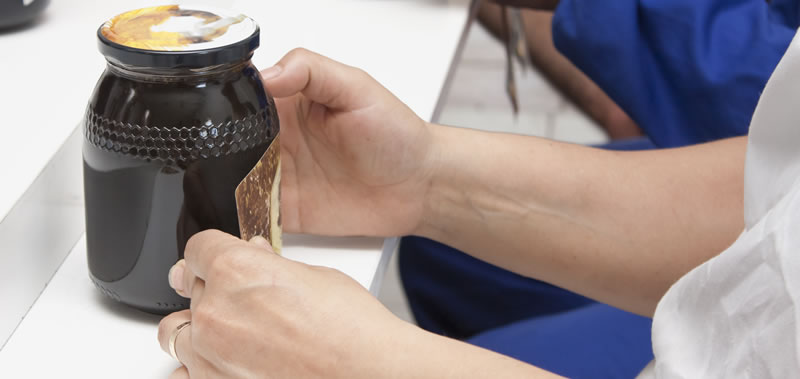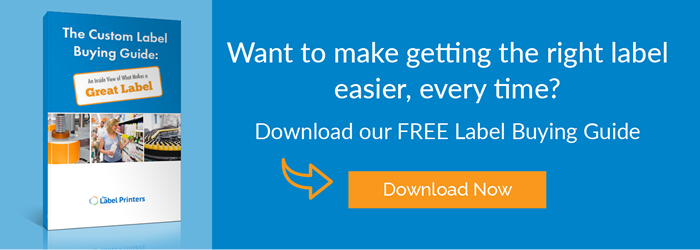
Believe it or not, there is a science to choosing the right label adhesive. The chemistry of an adhesive will react differently to the chemistry of different types of surfaces.
These different reactions can impact your brand in profound ways. How? Consider a beautiful, handcrafted bowl … that you have to scrub furiously to try and remove the sticky adhesive and bits of label left behind.
The last thing you want to do is frustrate your customers with a label that doesn’t perform the way you and they expect it to you. But the good news is that frustrating experiences like that are 100% avoidable – if your label vendor knows their adhesives.
When it comes to label adhesive types, three options are available: removable, repositionable and permanent. Let’s dive into what you need to know about each.
Removable? When?
So, you need a removable label? That simple request is often actually not simple at all. Allow us to demonstrate with a story:
Imagine you want to put a label on a tree. You’d like the label to be easily applied to the rough, uneven bark of the tree. You’d also like the label last for years, even in the wind, rain, and sun. And finally, you’d like the label to remove cleanly, without residue.
That’s asking for quite a lot from that label! Now, this is an extreme example, but it illustrates that many factors must be considered when creating a removable label.
Timeframe for Removal
First, it’s important to know the length of time you need the label to be removable. Will the label be applied once and left alone until it’s removed, or will you need to be able to remove and reapply the label if it’s accidentally applied askew? In a situation like this, you don’t actually need a removable label – you need a repositionable label (more on those later).
It’s interesting to note about 99% of adhesives build up strength over time. For some adhesives, that time may be relatively short – for example, there is a short span of time between when a label is placed on an apple and when the customer removes it. For other adhesives, the time frame is much longer, such as in the case of labels placed on cookware, decorative items, or other non-perishable items that may need to sit on a store shelf for several months but still need to be easily removed when purchased by a consumer.
Of course, the more expensive the item, the more this matters. If your product has a lower value, it might not make sense to spend the extra money on a removable adhesive. In this instance, perhaps you don’t mind if your customer has to scratch off a little adhesive.
Choice of Face Stock
Have you ever struggled to remove paper residue left behind when the label is removed?
This occurs when the wrong face stock has been selected. If a label is made from a weak paper but a strong adhesive, paper residue will usually be left behind. Most of us have had the frustrating experience of trying to peel endless tiny bits of price tag off a present before wrapping it.
A film label might be cleanly removable from a surface where the same adhesive on a paper label stock would have resulted in a mess of shredded paper and adhesive being left behind. That is because the film might be strong enough to pull the adhesive along with it when removed, while the paper might lack that kind of internal strength.
When A Removable Label Might be Best
A few common scenarios that warrant removable labels include:
- Produce: When a label is applied to food, it must be able to be removed cleanly from the surface of the food. No one wants to eat adhesive left behind on tomatoes or pears!
- Product labels and price tags: Nothing spoils a picture frame, a nice piece of china or a handsome notebook like a “removable” label that leaves behind a sticky outline of its former self. However, you may need the label to stay put for weeks or months of shelf-time.
- Patient charts or other medical information: Because information in healthcare settings is frequently updated, removable labels make it easy to stay organized and up-to-date.
- Car maintenance record decals: These stickers need to remain intact for several months and be able to survive numerous washes before they are removed.
- Reusable containers: Eco-conscious brands (and their sustainably-minded customers) recognize that reusability is near the top of the product packaging waste-reduction hierarchy – much higher than recycling, which consumes more resources and energy than you may realize. Removable labels allow your customers to repurpose your product packaging as a unique vase, a handy container, or simply a collectible conversation piece. Removable labels may also extend the life of refillable products, such as household cleaners, kombucha, or even craft beer. (Some consumers may be hesitant to reuse a bottle covered in grimy label gunk.)
- Asset tracking or record keeping: Keeping track of your inventory to prevent loss throughout the supply chain has never been more crucial. Nor has controlling the chaos in hectic health care settings ever mattered more. A specific type of removable label – piggyback labels – help with asset tracking and record keeping. Essentially labels within labels, piggyback labels let personnel quickly move barcodes and other tracking information from one surface to another.
Repositionable Labels
Repositionable labels often use an acrylic adhesive that can be easily removed and reapplied for a brief period of time after application. This helps ensure that human error when applying the label by hand does not result in a completely botched product. The ability to reposition these labels is a function of the chemistry of acrylic adhesives and the process the adhesive goes through to achieve a bond with the application surface.
When purchasing any labels, we recommend testing the adhesive/facestock combination on your application surface for 72 hours. This becomes especially important when repositionability is required, so you can see how easily it is removed and reapplied. This will save you from selecting a label that is not suited to your purposes.
Permanent Labels
Do you expect your label to stay for the long haul? Then you guessed it, you probably need a permanent label. As with removable and repositionable labels, there are still many factors to consider when making your selection, including:
- Will the label be outdoors and exposed to the elements, such as on heavy machinery or outdoor signage?
- Will your label be handled often?
- Will it come into contact with cleaning products or other solvents?
- What is the lifespan of the product, and how long does the label need to last?
- What temperatures will the label be exposed to, both during application and in use? For example, will the label be applied to a beverage container that might be immersed in ice, or will the label spend most of its life in standard room temperature conditions?
When a Permanent Label Might be Best
When Products Require Extra Security: When you want to stop the wrong people from opening your products – or you want to know when someone has tried – you need a label that isn’t easy to remove or replace. Tamper-proof and tamper-evident labels are a subset of permanent labels designed to protect a product’s authenticity, prevent misuse, and warn consumers about tainted contents. (In the case of pharmaceuticals, tamper-evident labels literally save lives.)
Outdoor Labels: Rain, heat, frequent temperature changes, and sunlight can wreak havoc on a label. If you want your label to last a long time outdoors, you’ll need to choose materials, inks and adhesives that can withstand the harsh elements. Your label printer can help you design (and test) a durable label that’s built to last.
Warning Labels: Warning labels are often mandatory and subject to specific regulations governing their color, language and design. Warning labels are also often subject to harsh conditions, especially in industrial environments, where caustic chemicals, intense heat, and moving parts can render labels illegible. Durable, permanent warning labels keep workers and customers safe, and they keep companies on the right side of the law.
Chemical Labels: Chemical labels are a special class of warning label subject to the Globally Harmonized System of Classification and Labelling of Chemicals (GHS). GHS-compliant labels must include hazard pictograms, a signal word and a hazard statement. But most of all, to do their life-saving job, chemical labels must resist disfigurement or destruction.
Automotive Labels: Cars and trucks are not only pieces of heavy machinery with moving parts, hot surfaces and corrosive chemicals, but they operate almost exclusively outdoors. This makes them a steep challenge for all but the toughest labels. Automotive labels must be permanent and durable (except, of course, temporary automotive labels, such as the maintenance decals mentioned above).
By being informed about the different label adhesive options available, you’ll be able to make the confident and correct choice for your next label project. When in doubt, The Label Printers is here to help answer any questions you have. We’re happy to guide you toward choosing the right label for your next launch.

